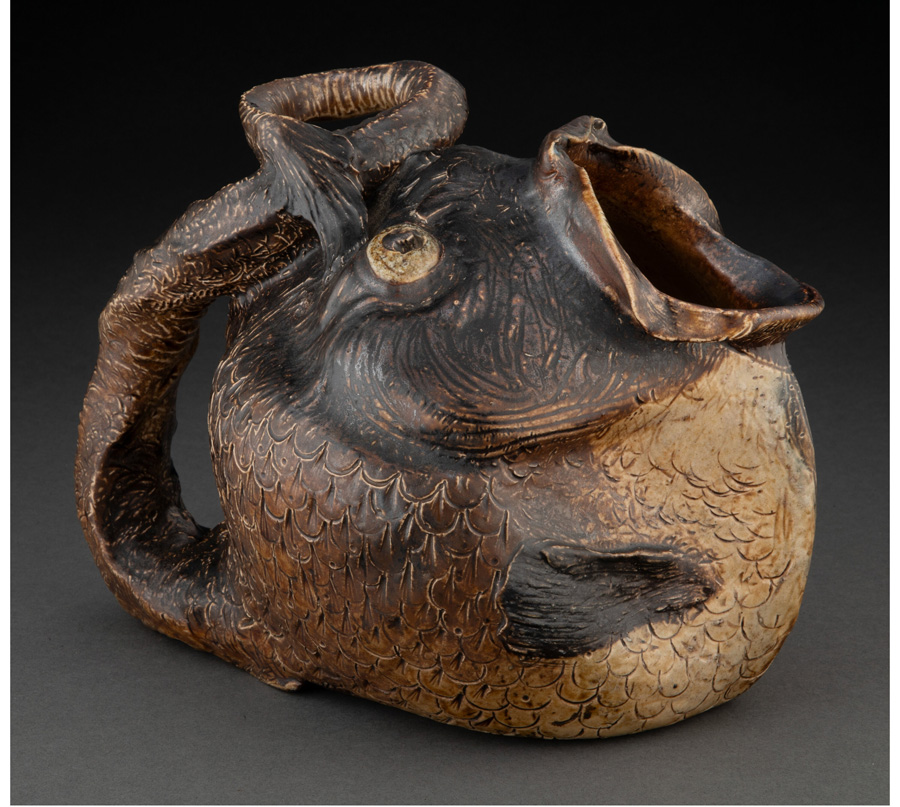THE FEARLESS FOURSOME’S PLAYFUL GROTESQUE WARES CHARMED 19TH-CENTURY LONDON AND STILL DELIGHT COLLECTORS TODAY
By Samantha Robinson
We have a hundred young sculptors who will model you a Venus or an Adonis as soon as look at you; but who save Mr. Martin could give you a Boojum or a Snark in the round?”
–William Cosmo Monkhouse, Magazine of Art, 1882
Founded in 1873 by four brothers – Robert Wallace, Walter, Edwin and Charles – London-based Martin Brothers is widely considered a primogenitor of the 20th-century studio pottery movement. For half a century, the firm produced distinctive functional wares and sculptural figures in salt-glazed stoneware. This choice of medium points to the British Arts and Crafts movement’s revival of early European artistic traditions, such as Continental salt-glazed stoneware of the 16th and 17th centuries, as well as the influx of ceramics from China and Japan. The brothers possessed a deep appreciation for and understanding of the material’s natural qualities and demonstrated impressive technical abilities. Due to limited financial resources, the brothers typically fired the kiln only once or twice per year, firing their dense stoneware vessels and figures at high temperatures and adding salt to the kiln. The salt fused to surfaces and produced thin, translucent glazes in subdued hues of browns, greens, blues and grays that highlighted rather obscured sculpted and incised elements.
Enlarge

Three of the four Martin Brothers creating a stoneware menagerie in their studio.
Photo by © Historical Picture Archive/CORBIS/Corbis via Getty Images.
While it produced a wide variety of products, Martin Brothers is best known for its whimsical grotesque wares in the form of anthropomorphized birds and chimerical creatures. The grotesque is a device that has recurred throughout the history of art, with origins in ancient Greece and Rome and resurgences during the Renaissance, the Baroque period and finally the Victorian era. Defined as a comically distorted motif with mixed human, animal or plant elements, the grotesque challenges its viewer to grapple with themes of dichotomy, hybridity and metamorphosis. John Ruskin, a leading art critic of the period, argued that the grotesque elicits a dual response, both amusement and discomfort.
Wally Bird tobacco jars are the most iconic of the Martin Brothers’ grotesque wares. Named after eldest brother Robert Wallace, Wally Birds do not depict specific species but instead a combination thereof, characterized by upright posture, exaggerated features and comical expressions. The Birds were not merely decorative but imbued with a sense of satire and commentary, reflecting the brothers’ observations of society. These avian-human amalgams served as caricatures of their metropolitan Victorian viewers and met their gazes with defiance and mockery. Indeed, one senses judgment in the skeptical, sidelong glance of the large Wally Bird featured in Heritage’s April 18 Pursuit of Beauty auction.
Other types of grotesques appear throughout the firm’s output, such as fictitious beasts and sea monsters. Heritage’s upcoming auction also features an exceptionally large tobacco jar in the form of an unidentified creature that is sure to delight Martin Brothers collectors, for whom the stranger, the better. Gazing upward and stretching its beaklike lips into a wide, toothy grin, its squat, distended body is covered in fur and scales and rests on four feet reminiscent of an elephant’s.
Another highlight is a massive spoon warmer in the form of a bulbous fish with bulging eyes, gaping mouth and elongated eel-like tail. During the Victorian period, such a vessel would have been placed on a dining table and filled with boiling water to keep serving utensils warm. Another spoon warmer in the auction is so bizarre that it’s impossible to decipher which actual species – if any – may have inspired the brothers.
Large Martin Brothers Glazed Stoneware Grotesque and Long Beaked Bird Jar and Cover, circa 1884. Sold for $81,250 in a November 2016 Heritage auction.
By the beginning of the 20th century, Martin Brothers grotesques had become a popular collector’s item, prized by Pre-Raphaelite painters Edward Burne-Jones and Dante Gabriel Rossetti and championed by Queen Mary, who in 1914 ordered 60 pieces for the Paris Exposition. Today, the Martin Brothers’ stoneware is highly prized by collectors and museums worldwide, celebrated not only for its artistic merit but also for its role in the history of ceramics. Their work represents a bridge between traditional pottery techniques and the modernist movements that would follow, embodying the principles of the Arts and Crafts movement through their commitment to handcraftsmanship and individual expression.
Heritage’s April 18 Pursuit of Beauty: Art Nouveau, Art Deco & Art Glass Signature® Auction features property from an Important Private Collection of Art Pottery, a comprehensive collection of 19th and 20th century works including Martin Brothers and their contemporaries in Continental Europe (such as Pierre-Adrien Dalpayrat, Clement Massier and Amphora) and the United States (including George Ohr, Fred Robertson and Newcomb). It boasts more than a dozen Martinware pieces that demonstrate the firm’s diverse output, from the aforementioned grotesques to vases with relief or engraved decoration.
 SAMANTHA ROBINSON is Director of Decorative Arts & Design in Heritage’s Chicago office. She can be reached at SamanthaR@HA.com or 214.409.1784.
SAMANTHA ROBINSON is Director of Decorative Arts & Design in Heritage’s Chicago office. She can be reached at SamanthaR@HA.com or 214.409.1784.






